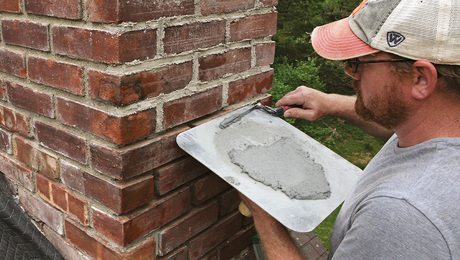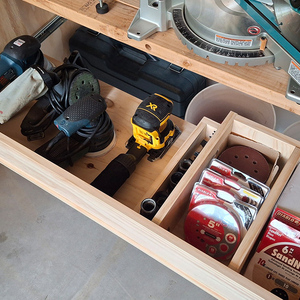What methods/tools do you all use to pry trim that you are going to reinstall?
<!—-><!—-> <!—->
Here is what I did:
- hammered a putty knife into the seem between the trim and the wall just next to one of the nails
- pried it up a bit to create a small gap
- inserted a small 6†pry bar into the gap
- using the pry bar, pried out the first nail by prying the trim away from the wall
- moved down the trim repeating 3 until all the nails were out
<!—-> <!—->
This worked fine except for step one which slightly damaged both the trim and the wall. Is there a better tool or technique for this?
<!—-> <!—->
Thanks, Mischa



















Replies
That's pretty much what I do except that I begin with a 5-in-1 painters tool followed with an 8" flat bar.
I try to start in the least noticeable place and not try to pry it too far, too fast. I get it started, then go hand over hand along the length of the trim prying it a little further with each pass. When I can get a grip on it, I apply light pressure with my hand and use the flat bar to persuade it past the tight spots.
Be careful with mitered casings that may have been "pinned together" with a nail thru an edge. You may need to loosen both of the mitered pieces to get them apart without tearing out a corner.
Don't forget to score any paint along the edge of the trim before you start prying. Peeling off large chunks of latex paint is a real PITA. - lol
Get a sharper putty knife. I generally use a stiff knife that's been sharpened to a modest edge.
You can also use a drift punch and drive the finish nails through the trim.
I start by cutting any caulk with a utility knife.
Chuck S
Another point: When using the pry bar, place the putty knife behind it against the wall, and pry against the knife. This keeps the bar from denting the plaster.
I do similar, except I like to use a wide spackle knife against the wall to pry against. It spreads the pressure on the sheetrock, so I don't leave holes in the wall. When I use the wide knife, I can use my WonderBar to get more leverage to pop the trim off.
I also like to work my way down the wall loosening the trim a little at a time, instead of trying to get one section free all at once. I find I can get the trim off in one piece much more easily that way. Especially on older, brittle trim.
And like someone already said, its important to cut the caulk along the top of the trim. That stuff can really hold things together.
I cut the paint seam first with a utility knife, then slide a thin flexible putty knife in there first. As soon as I read the word 'hammered' if flinched knowing that you had bruised wood
Welcome to the
Taunton University of Knowledge FHB Campus at Breaktime.
where ...
Excellence is its own reward!
I use a tack puller to start. It still mars a little but its not bad if you're careful.
The main thing to remember here is go slow. Cutting back the paint may help too.
Family.....They're always there when they need you.
I relish the challenge of getting old trim off in pristine condition. All of the above make very good points, but the guy who suggested cutting the caulk bead and pin punching the nails back thru the work was on the money.
But you need a good 3/32 punch. The ones by Baltimore (sold at Lowes) are total ####. Craftsman makes a marginally beter punch and they replace it when it breaks. But the best are the blue ones... not sure, but I think Dasco. They will outlast 3 or 4 of the others but get 2 anyway, because you're likely to break one before you get the feel of it.
Its relatively easy to suss out nails in clear finish trim. If its painted shine a strong light on a long angle across the work. Casing trim nails won't be on layout, but baseboard and crown will... so once you find something there you can look on 16" centers for more.
You won't find them all, but every nail you do find and punch back thru makes for a better pry off. When you get the trim off lever any remaining nails thru from the back with a pair of nippers or vice grips.
I wouldn't argue that I do "fine carpentry", but I favor taking the nails out through the front. To avoid splitting the wood face when tapping them out I place the piece of trim face-down on a sacrificial block and give the nail point a few taps. This prevents splitting, and you can renail through the same holes.
In science it often happens that scientists say, "You know that's a really good argument; my position is mistaken," and then they would actually change their minds and you never hear that old view from them again. They really do it. It doesn't happen as often as it should, because scientists are human and change is sometimes painful. But it happens every day. I cannot recall the last time something like that happened in politics or religion. --Carl Sagan
If tapping nails out thru the front works for you, keep doing it. I haven't had much luck with that method.
I bought a pair of Extractor pliers a year or so ago. They make pulling the nails from the back very easy.
And I'd rather not renail thru the old holes. They're frequently worn a bit, and I don't think the wood is held as tightly. If you pull thru the back, the old holes are still filled, and you "just" have to fill the new ones.
When removing trim that has to be put back on I always make sure to cut any paint or caulking along the top and/or sides of the trim. When the entire area(room) is free I use a small furniture restoration bar and lightly pry only enough to get my larger furniture restortaion bar in. I've found the larger surface area better suited for removing trim. You will have far less trim to glue back together. I find the only time that ever happens to me with this method is with brittle old Fir. After I've removed the trim I pull the nails through the back of the trim with a dull pair of side cutters or chanel locks if the side cutters aren't doing the job. I prefer to pull the nail through instead of taking it out the face of the trim to avoid damaging the front of the trim. This method also leaves the original nail hole filled. I've also found that if the trim has been nailed exceptionally well and I'm having a great pains in removing it I'll use a pair of side cutters to cut the nails when I've pried the trim back far enough. I've seen six inch finish nails used to put baseboards and casings on.
I keep a piece of half inch oak veneered plywood I use to pry against if I need to in my finishing tool bag. It's comes in handy when removing casing. I also pry from the mitre when removing casing. I've seen too many carpenters ruin casings because they didn't consider that a good deal of casings are nailed at the joints. Make sure you have enough to pry on. If you have too little you run the risk of cracking the casing.
Lastly I would suggest using your ears. Most if not all the time you'll hear it cracking before it becomes a real problem that requires glue and clamping. Also pry on the meatier part of the trim. You'll have far less headaches.
I bought my furniture restoration bars at Lee Valley. The part that pries is thinner than almost every other bar I've seen and very strong.
same that's been said.
I prefer a 6" drywall knife.
use the utility first to cut the caulk / paint line ...
hammer in the drywall knife ... wiggle ...
start with the little japanese cats paw / pry bar ...
depending on the trim move up to a wonder bar, again ... prying against the drywall knife. If it's big fat old trim that's really stuck ... I'll slide a 12" drywall knife in behind the 6", and slowly but surely crank away.
I also prefer to pull the nails evther thru ... and have them stuck in the wall ...
or out the back with a pair of end nippers.
then end nip them out of the wall.
usually works ... sometimes no matter how careful ... U lose one.
Jeff
Buck Construction
Artistry In Carpentry
Pittsburgh Pa
What DanH said ... plus you can cut through the finish nails with a hacksaw blade + handle to avoid having to pry the trim too far (if old / brittle).
Jeff
I have, on occasion, used a recip saw with a metal blade to cut the nails once I've wiggled it loose a bit.
Usually on wider, older base where too much prying would break the trim, or on wide casing I want to save. It does take a little bit of a light touch, but it's not that hard to develop the feel.